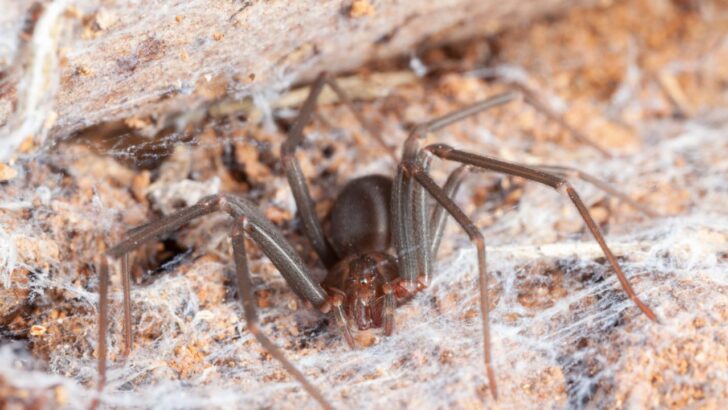Spring’s arrival is something we eagerly await, with warmer days, blooming flowers, and brighter skies. But something else is waking up with the thaw—and it’s not as heartwarming as your first glimpse of crocuses.
Once spring hits, bug populations wake up and spike as temperatures climb. Pest World experts share that erratic weather patterns that lead to a yo-yo of warm and cold days can lead to a sharp increase in pests like ticks, ants, and mosquitoes.
At What Temperatures Do Bugs Emerge?
Spoiler alert! Most bugs have been “hibernating” all winter and will begin to wake up as the ground thaws.
Many bugs found in our yards enter a state of inactivity called diapause during winter, only to emerge in force as the mercury rises above 50°F. It will vary with each species, but generally:
- Ticks start to stir around 40 degrees F
- Ants, mosquitos, and wasps wake up once temperatures get above 50 degrees F
Different regions will have different experiences. In Southern states, for example, mosquitoes can be a year-round issue; in Northern states, they are typically limited to spring through late fall. In colder climates like Canada or Alaska, temperatures must stay consistently warm before pests come out of hibernation.
What Else Brings Pests Out in Full Force?
The environment isn’t the only factor that attracts bugs during springtime. Human activity also plays a significant role in bug infestations. For example:
- Standing water provides the perfect breeding ground for mosquitoes
- Pollen and plant debris attract ants, which can become a nuisance when they start invading homes in search of food
- Trash or clutter in yards can attract various pest species
Unfortunately, weather changes that are out of our control can contribute to a sudden surge in bug populations. If there seem to be more pests around than usual despite efforts to manage them, this might be why. For example, last year’s 2024 forecast from The National Pest Management Association predicted that unusually warm and wet spring weather would mean earlier emergence of pests and a quick uptick in pests like ticks, ants, and mosquitos.

Photo Credit: Pest World.
The Top Bugs Starting to Make Their Appearance
Termites
Nicknamed “the silent destroyers” for a reason, termites become active in spring, especially in warm and moist regions like the Southeast U.S. Subterranean termites begin swarming to establish new colonies, creating a significant risk to wooden structures. Their taste for wood’s cellulose can lead to thousands of dollars in structural damage if undetected.
What You Can Do:
- Inspect for Mud Tubes: Termites create mud tunnels on walls, foundations, or beams. Watch for these warning signs.
- Prevent Moisture Build-Up: Repair leaks and ensure proper drainage around your home since termites are drawn to damp environments.
- Schedule a Termite Inspection: Professional assistance is vital to spot early infestations.
Ants
Ants, particularly pavement ants, odorous house ants, and carpenter ants, become highly active as the weather warms across the U.S. While some are merely annoying, carpenter ants are a bigger problem. They hollow out wood to build their nests, making structural damage a real concern.
What You Can Do:
- Store Food Securely: Keep all food in airtight containers and clean up crumbs promptly.
- Address Moisture Problems: Fix any damp or decaying wood in the home to reduce the appeal for nesting.
- Seal Entry Points: Use caulk to close off cracks that ants can use to enter your home.
Cockroaches
Cockroaches are spring’s other hardy survivors in the Southwest. These nocturnal pests take shelter indoors during the winter but increase their search for food and water as the days warm. Unfortunately, they’re more than just creepy roommates; cockroaches can spread bacteria and allergens.
What You Can Do:
- Clean, Clean, Clean: A spotless kitchen and bathroom are critical in avoiding a cockroach infestation.
- Fix Leaks: Repair leaky pipes and faucets to eliminate their water source. This is important since other creepy crawlers like millipedes, centipedes, and earwigs thrive on moisture as well.
- Use Traps: Employ cockroach traps in problem areas while keeping clutter minimal.
Spiders
Spiders follow their prey indoors and become more visible in early spring as insect activity picks up. While most spiders are harmless, encounters with venomous species like brown recluses or black widows can become dangerous and found throughout the U.S.
What You Can Do:
- Declutter: Basements, attics, and other storage areas are prime spider hideouts. Keep these areas clean and tidy.
- Eliminate Other Bugs: Reducing the number of insects in your home will naturally limit spider activity since they follow their food source.
- Seal Cracks: Keep spiders out by eliminating entry points around windows, doors, and utility lines.
Ticks and Mosquitoes

Photo Credit: Deposit Photos.
Ticks and mosquitoes are unwanted nuisances that can double as health hazards. Ticks that overwintered on animals or in sheltered areas emerge hungry, and mosquitoes soon join the fray as standing water from snowmelt provides perfect breeding grounds. Both pests can transmit serious diseases including Lyme disease and West Nile virus.
What You Can Do:
- Check for Ticks After Outdoor Activities: Always perform tick checks after walks in wooded or grassy areas.
- Remove Standing Water: Clear out buckets, pots, and other areas where water can collect and become mosquito nurseries.
- Consider Professional Treatment: Targeted mosquito and tick control can significantly reduce local populations.
Wasps and Other Stinging Insects
Queen wasps wake up in spring and begin building their nests.
Early discovery is key since a small manageable nest can grow into a buzzing colony by summer. These pests can pose a painful threat, especially for those allergic to stings.
What You Can Do:
- Remove Nesting Areas: Regularly check for nests under eaves, patios, and backyard decks.
- Avoid Sweet Foods Outdoors: Wasps are attracted to sugary drinks and foods, making outdoor dining a challenge without taking precautions.
- Destroy Nests Safely: Use a pressurized wasp spray at night when wasps are less active, or hire a pest professional.
Spring into Action
While springtime pests may seem inevitable, prevention is your best tool for managing their transition from dormancy to full-blown nuisance. Seal your home tightly, eliminate excess moisture, and keep a clean household to discourage unwanted guests. For tougher infestations, don’t hesitate to call a pest control professional who can help you reclaim your space and enjoy a pest-free spring.
Read More:
Garden Pests That Look Harmless but Will Destroy Your Plants
The Best Natural Remedies for a Pest-Free Garden, According to Experts


